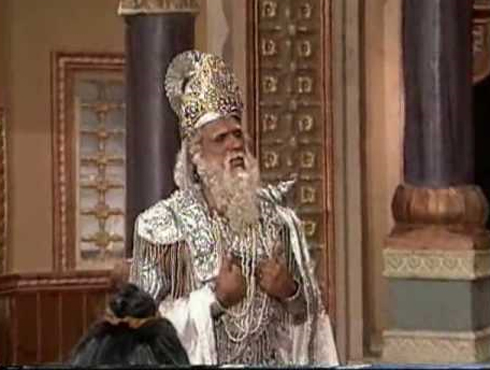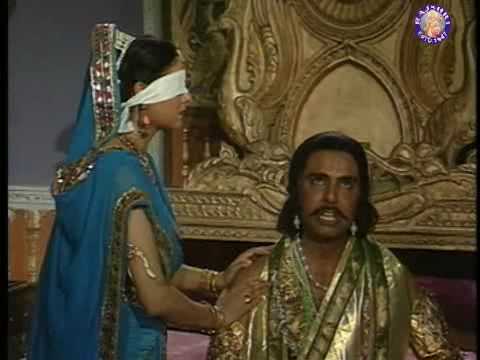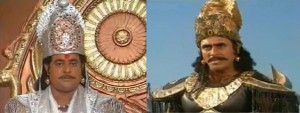
We have received some offline questions (though comment questions are preferable since all can see) about why, if I think Prema/Bhakti is the highest of qualities, I have been so critical of Dhritarashtra and Gandhari. Some see a contradiction between my emphasising Dharma over parental attachment—but nothing could be further from the truth.
Our shastras discuss how the Arishadvargas (the 6 spiritual enemies) are to be defeated. These are Kama (lust), Krodha (wrath), Lobha (greed), Moha (attachment), Mada (pride), Matsarya (jealousy).
While Mada is the worst of these (because it is the enabler not only of Ambition but is the Arishadvarga that gives us permission to give in to the others—as Ravana famously showed), Moha is also exceedingly dangerous. This is because even Dharmic and Sattvic people can give into this one—after defeating the other 5.
Moha is attachment rooted in delusion. Moha comes from the mistaken thinking that this material world is permanent, our bodies permanent, and even our relationships permanent.
Moha leads to such foolhardy and overly sentimental actions as Bhishma’s Oath and Gandhari’s Vow.
Both of these actions were undoubtedly self-sacrificing and even noble, and could be seen as examples of Prema, but they were in actuality contrary to Dharma. This is because as crowned Yuvaraja of Hastinapura, Gangaputra Bhishma (literally meaning “Terrible Oath”) did not have the authority to put his love for his father above his duty for the Kuru Kingdom and his duty to continue the Dushyanta branch of the Chandravanshi lineage.
In fact, Devavratha (Bhishma’s original name) should have known that as he was the most qualified heir Shantanu could possibly hope to have, it would be wrong to deny such a future King to his prajas (subjects). After all, there was no guarantee that future sons of Shantanu would be so qualified or capable (as both Chitrangada and Vichitraveerya demonstrated). In fact, there was no guarantee that Shantanu would even have sons with Satyavati. Thus while Bhishma action was truly self-sacrificing and sentimental, it was not Dharmic, or for that matter, even selfless—as the he was unwilling to break his oath on account of his own reputation.
As the later incident with Dushasana and Draupadi showed, Bhishma’s own understanding of Dharma was imperfect. When Draupadi in disbelief asked why the noble Bhishma thought his oath to the throne came before protecting a woman, he is recorded to have said:
na dharmasaukshmyaat subhage vivektutm shaknomi te prasnam imam yatthaavat;
“I am unable to answer your question because Dharma is subtle”
(dharmasya tattvam nihitath guhaayaam) “Dharma is subtle (sukshmam) because its essence is concealed in a dark cavern”
But he was wrong.
While dharma is sukshmam (in fact, it is ati-sukshmam), there is nevertheless a right and wrong answer in every scenario. It is the duty of each person not to conceal it and himself in a dark cavern, but to use the light of logic (nyaya) and justice (yuktata) to illuminate Dharma. As a kshatriya mandated to protect women and the weak, Bhishma’s dereliction of duty to Draupadi in fact was the true reason for his suffering on the Kurukshetra (just as Yudhisthira’s brief tour of Hell was not for the one lie but in actuality for ordering that his brothers respect his foolish and unjust wagering of Draupadi). People may say that Bhishma had no choice because he was bound by his word, but there is always a choice.
Sri Krishna had in fact given his word to Duryodhana that he would not fight in the war. But the moment Krishna realised that Arjuna was not willing to take Bhishma’s life in battle due to moha, Krishna took up the wheel to strike Bhishma. This demonstrates that if dharma itself will ultimately be violated by the promise or oath, then the oath too must be dropped—not because it is easy, but because it is hard. While Gangaputra is often—and not unjustifiably—seen as an object of sympathy and pity for his life of suffering and self-abnegation, the sins against dharma include sins of omission as well as sins of commission. Bhishma’s sin of omission (failure as a kshatriya to protect a woman being dishonoured) resulted in his own suffering. His attachment was to his oath and reputation.
Similarly, Gandhari was undoubtedly a devoted wife and loving mother, but her action, in covering her own eyes as a testament of her loyalty to her husband and willingness to share in his suffering, was foolishness. The duty of a wife is surely to be faithful and loving to her husband, but it is also to give him sight when he does not see properly.
Thus, Gandhari and Dhritarashtra are more than just stock characters with a particular affliction, but in fact metaphors for how Moha can blind us to Dharma. Their attachment to their family members, especially their sons, was the cause for their repeated injustice to the Pandavas—which ultimately led to adharma. Thus both Bhishma and Gandhari represent the dangerous hyper-sentimentalism present in our stupid movies today.
Moha also leads to terrible Sin
Rather than conscious desire to do evil, it is thoughtlessness driven by animal urges or fears driven by attachment that most frequently cause us to commit injustice. Some can be small, moral infractions, and others, large and terrible. For all the Star Wars fans out there, it was fear of losing the love of his life that drove Anakin Skywalker to embrace the Sith and commit terrible acts on behalf of the Dark Side.
That is the importance of Acara and Dharma. It wasn’t Anakin’s conscious desire to commit evil or that he was seduced by it for pure personal gain; it was that he was willing to commit a terrible evil against society for the all too human, but still very selfish, personal end of saving the one he loved. He had failed to use Acara to bridle the horses of his emotions and senses, thereby causing his chariot to fall over, resulting in this unenviable fate–ultimately becoming the infamous Darth Vader.
In contrast, Obi-Wan (who was his mentor) says he will do what he must despite their friendship, in the name of justice. Kenobi’s grief is seen (at the end of the video) when he exclaims how Anakin was like a brother to him, and mourns how the latter’s turning to the Dark side led to this terrible result. More compellingly, Anakin’s wife herself specifically states that she cannot follow him on the wrong and horrendous path he’s chosen.
Thus, no matter how much she loved him, her love never became attachment over a person or object that privileged him/it over virtue. That is the value of Dharma. It is not to turn us into feelingless, loveless karma-robots, but rather to protect ourselves from an imbalanced attachment to one person/object that causes us to harm the rest of society. (By the way, before the all you fashionable types shake your heads at my linking Star Wars with Acara/Dharma, you should know that there is an established view that the kshatriya ideal was in fact the model for the Jedi …so there!).
The 7 should defeat the 6
7 ideals of Dharma— Pavitrata (purity), Karuna (compassion), Saamyama (self-control ) Satya (truth), Tyaga (self-sacrifice), Yuktata (justice), and above of all Bhakti/Prema (Divine love)—must take precedence over and defeat the 6 arishadvargas—Kama (lust), Krodha (wrath), Lobha (greed), Moha (attachment), Mada (pride), & Matsarya (jealousy).
Kama is cured through Pavitrata, Krodha is cured through Karuna, Lobha is cured through Saamyama, Mada is cured through Satya, Matsarya cured through Tyaga, and Moha is cured through Yuktata. Bhakti/Prema is what grants us God’s grace to ensure the rest of the 7 defeat the 6.
Some of you may ask, how is each cured by the other. I will tell you:
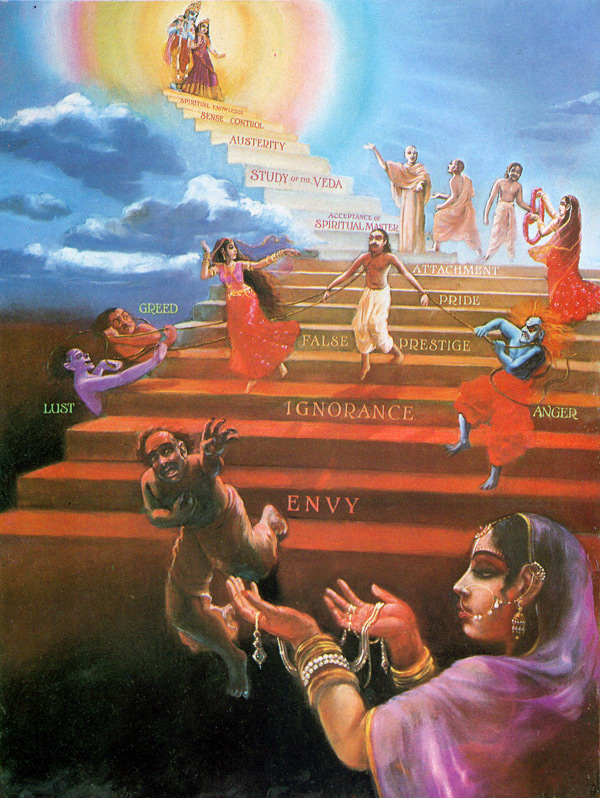 Pavitrata deconstructs Kama
Pavitrata deconstructs Kama
…because it forces us to think whether a particular act of pleasure is in fact saucha (or clean). Many of you have sophisticated imaginations (especially in this post-Lewinsky/Abhishek Manu “Sexvi” era of ours), so I needn’t go into detail, but suffice it to say, you all can figure out which acts would come under this label.
Therefore, the point is not that God wishes to deny us pleasure, but rather, to make us understand that there is a time, place, and most importantly—manner for which pleasure is to be enjoyed. Pavitrata is of course not only about understanding body parts, but also about relationships.
While kama with one’s lawfully wedded wife or husband is not only accepted, but also seen as a duty (as it reproduces species, nations, and lineages), the Shastras explicitly condemn pleasure that transgresses the nuptial or familial boundaries. Extra-marital and intra-familial relationships are therefore impure as well. Extensions of this also apply—and should be obvious. A man who gives himself (or a woman who gives herself) over to lust and surrenders to iccha (desire) without restraint, will soon find himself (or herself) feeding and rolling at the filthy trough of swine (literally and figuratively). Of course, we must not be hypocrites by engaging in bigotry and also recognize that we are all at different stages of spiritual evolution (and thus, if we cannot live up to the highest, should attempt the next highest, and so on).
As we ourselves have not always (at least in previous life times) always lived up to the ideals set by God, we must recognize that the same understanding and leeway be granted to others as well, within legal limits. Youth should be taught the difference between right and wrong, but also that wrong in others should not generate hate. After all, let ye without sin cast the first stone… An entire column can be written on this (and in fact will be), but we’ll leave it at that for now.
Karuna defeats Krodha
 …because it forces us to think of the consequences of our anger and put ourselves in the shoes of others.
…because it forces us to think of the consequences of our anger and put ourselves in the shoes of others.
Anger and Hate are exceedingly dangerous because they can consume our personality and reduce us to sating our desire for vengeance at all costs. Compassion dissipates anger because it makes us realise that our predicament may actually be more bearable than someone else’s, thereby mollifying our indignation. This approach also drains our pride which is the fuel of anger.
We must give a margin of appreciation (5%–though not 50%!) to those around us, so that we understand that their actions may often be due to their own troubles. There is a difference between thoughtlessness and malice. Thus, karuna helps us reframe our perspective and not unyoke our wrath at the slightest provocation. A man who is ruled by krodha is a beast for he neither listens to logic nor well-intentioned appeal. It is for this reason that we are told “To err is human, but to forgive is divine”
Saamyama cures Lobha
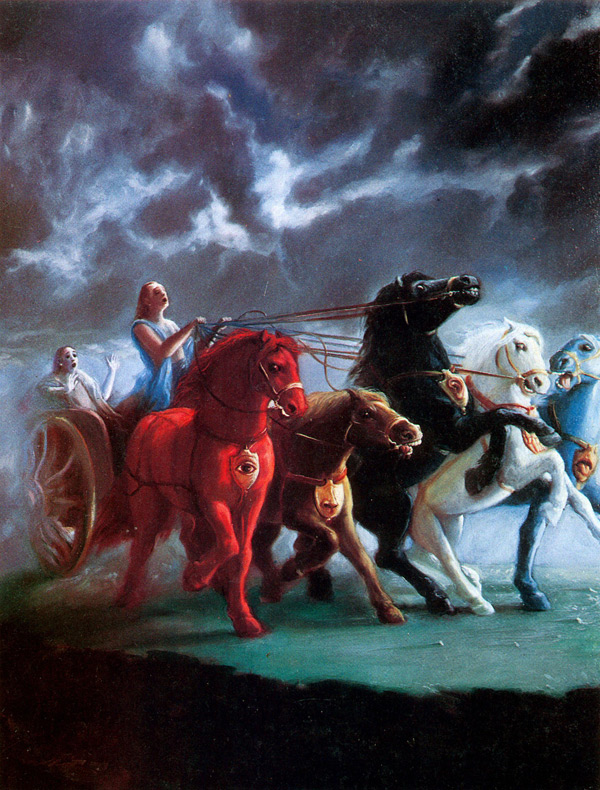 5 senses must be steered to steady the chariot of life
5 senses must be steered to steady the chariot of life
… because self-control gives us the power to resists the appeal of the indriyas (senses ).
It is for this reason that our ancient society encouraged ascetism—not because self-abnegation by itself is the path to God, but rather, because ascetism helps us blunt the power of the indriyas. If we fast or do without something on our terms—say skip a meal or do without TV for a day or give some wages to charity—then when we are going through an actual difficult period, the sense object will not be irresistible, as we have resisted it before from a position of strength.
In fact, ascetism is one of the four legs of Dharma (the other 3 being cleanliness, mercy, and truth), though it was bent at the end of the Satya yuga. While in our own Kali era, Dharma only stands on the leg of truth (and barely standing at that), all four legs, even ascetism, should be recognized for how they help us better ourselves, especially when it comes to resisting greed.
Satya defeats Mada
… as it forces the individual blinded by delusional arrogance to face reality. Many if not most of us live in a realm of concocted conceit.
We mask ourselves to truth either because it is too unpalatable to face or because it would prevent us from achieving our own ill-conceived and unjust ambition.
We may desire something, a natural impulse in our material existence, but it is pride which gives us permission to seek it out. We may come up with umpteen excuses to justify our pursuit of a beautiful but very married woman (i.e. “we are both attractive and she too likes me, we are a better match anyways, so why not? I am a powerful man with powerful appetites”), but it is Satya which pops this bubble (“I have no right to covet my neighbor’s wife. If I injure someone today, they may seek to injure me tomorrow. Ultimate power is wielded by God, I am only the steward, so my fleeting power does not justify such appetites”). That is the power of Satya. Facing and wielding the truth helps us hammer down the wall of pride and vanity into oblivion.
Tyaga overthrows Matsarya

…since self-sacrifice allows us to accept, digest, and even be happy for the wealth, possessions, and advantages of another.
If we are willing to step aside for the gain of another, then we are willing to swallow our envy, which stews into jealousy (jealous = envy + hate). The spirit of self-sacrifice stems from the noble calling of “all for one and one for all”. The four sons of Dasharatha exemplified this as their brotherly love and willingness to sacrifice for the others ensured that jealousy never subverted their unity–no matter what catastrophe came their way.
Because they were each willing to give up the throne, or even life, for the other, this noble sentiment ensured that the one who deserved the throne was the one who ultimately ascended it…neither of them ever claimed the right or possession of the other. This not only secured unity among them, but preserved and nurtured fraternal affection.
And Yuktata cures Moha
…due to the illuminating quality of justice.
Attachment causes us to only look at what will happen if we lose a person or an object. We only think of our personal sadness rather than the cost to the common good. But justice is concerned specifically with the common good, with rightful claims, with fair shares, and with the well-being of everyone. Thus, no matter how much one may be attached to a son, a wife, or a desire–justice will force us to put aside that attachment and do not what is merely in our own interest, but in the interest of all.
While the 7 may be the Astras against the 6, Atma vichara (self-reflection/introspection) and Viveka (discrimination between right and wrong) are the respective bow and arrow that allow us to fire these 7 Divine weapons…and as always, God’s name is the empowering mantra we chant to wield the weapons properly.
Thus, true Bhakti & Prema are based not on the attachment to the individual relationship, but on recognition that we are all emanations of Parabrahman, and that our love, ultimately, should transcend fixation only on the ephemeral relationships of this life and extend to all living creatures for all time. That is true Prema.
So love, dear reader, love to all your heart’s content, for verily Satya is love (and sringara (romance) also a celebrated part of our tradition). But also remember that true Prema is not, nor can ever be, Moha.
